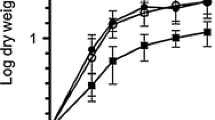Abstract
Streptokinase (SK), an extracellular protein from Streptococcus equisimilis, is secreted post-translationally by Escherichia coli using both its native and E. coli-derived transport signals. In this communication we report that cleavage specificity of signal peptidase I, and thus efficiency of secretion, varies in E. coli when SK export is directed by different transport signals. The native (+1) N-terminus of mature SK was retained when it was transported under the control of its own, PelB or LamB signal peptide. However, when translocation of SK was controlled by the OmpA or MalE signal peptide, Ala2 of mature SK was preferred as a cleavage site for the pre-SK processing. Our results indicate that compatibility of the leader peptide with the mature sequences of SK, which fulfils the requirement for a given secondary structure within the cleavage region, is essential for maintaining the correct processing of pre-SK. An OmpA-SK fusion, which results in the deletion of two N-terminal amino acid residues of mature SK, was further studied with respect to the recognition of alternative cleavage site in E. coli. The alanine at +2 in mature SK was changed to glycine or its relative position was changed to +3 by introducing a methionine residue at the +1 position. Both alterations resulted in the correct cleavage of pre-SK at the original OmpA fusion site. In contrast, introduction of an additional alanine at +4, creating three probable cleavage sites (Ala-x-Ala-x-Ala-x-Ala), resulted in the recognition of all three target sites for cleavage, with varying efficiency. The results indicate that the nature of the secondary structure generated at the cleavage junction of pre-SK, resulting from the fusion of different signal peptides, modulates the cleavage specificity of signal peptidase I during extracellular processing of SK. Based on these findings it is proposed that flexibility in the interaction of the active site of signal peptidase I with the cleavage sites of signal peptides may occur when it encounters two or more juxtaposed cleavage sites. Preference for one cleavage site over another, then, may depend on fulfillment of secondary structure requirements in the vicinity of the pre-protein cleavage junction.
Similar content being viewed by others
Author information
Authors and Affiliations
Additional information
Received: 22 September 1997 / Accepted: 17 December 1997
Rights and permissions
About this article
Cite this article
Pratap, J., Dikshit, K. Effect of signal peptide changes on the extracellular processing of streptokinase from Escherichia coli : requirement for secondary structure at the cleavage junction. Mol Gen Genet 258, 326–333 (1998). https://doi.org/10.1007/s004380050738
Issue Date:
DOI: https://doi.org/10.1007/s004380050738




